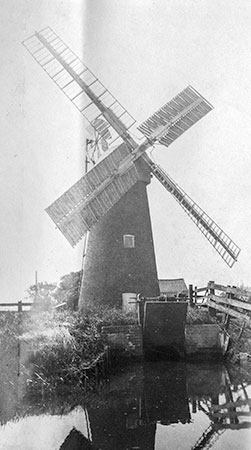
c.1915
|
Tunstall
Stracey Arms drainage pump River Bure |
 |
c.1915 |
Stracey Arms drainage pump was built beside the road that became the A47 trunk road and was designed to drain the marshes into the River Bure. The now slightly leaning 4 storey red brick tower had a Norfolk boat shaped cap with a petticoat. Power to the internal turbine pump was supplied by four patent sails and the cap was turned to wind by a white & red striped 8 bladed fantail with a Y wheel and a tailpole. In the mills earlier days it was known as Arnup's Mill. |
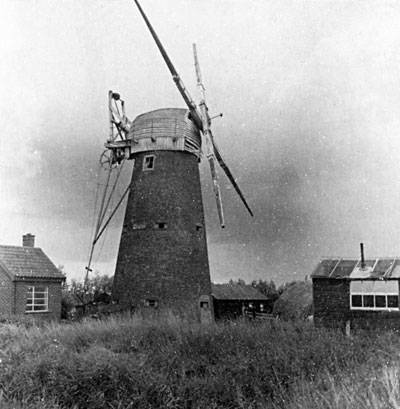 |
1950 |
During World War II the tower was converted to a pillbox, complete with gun ports. |
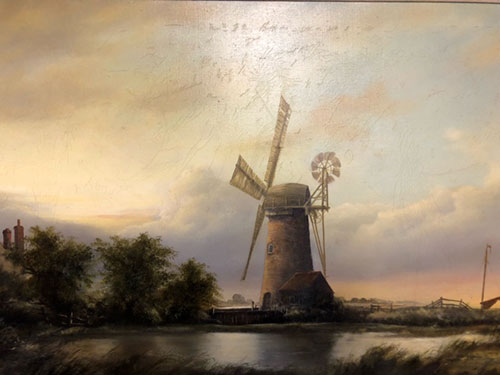 |
Oil painting by unknown artist |
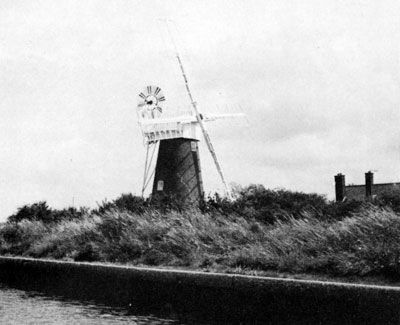 |
July 1985 |
The site was eventually taken over by The Windmills Trust and the mill was restored. The adjacent mill house was set out with a photographic display of depicting the history of Norfolk's drainage pumps. |
Hope of cash boost to restore windmill
|
The continuing quest to Restrore Norfolk's historic windpumps could be boosted by almost £20,000. After 10 years of repair work to the windpumps, the Broads Authority has reported success in its preservation efforts. And it now hopes it can keep up the work with funds boosted from last year's figure of £12,500 to £30,000 by the year 1994. Historically the windpumps are the most renowned sight along the flat marshes of the Norfolk Broads, say officers working on the Broads Windpumps Programme. And yesterday saw the most accessible of all the windmills, the Stracey Arms on the Acle straight, take its cap off to restoration by proving the success of the programme. The windpump, which was built in 1883, was given new timber under its cap after the old wood had deteriorated and become dangerous, said millwright John Lawn. The £4000 project included putting sails back into place, with the whole operation ensuring the windmill could safely open to the public by Easter. People were being encouraged to search out the history behind the pumps, said conservation officer Caroline Davison, who added that the Stracey Arms had been used as a gun emplacement in the second world war. "There are a lot of windmills which still need work carrying out to them. The programme hopes to restore and preserve as many as possible," she said. The windpumps programme is a major operation on up to 70 of the brick towers still remaining. With support from the Windmills Trust and Norfolk County Council the idea is to promote restoration while preserving the profession of millwrights. Displays and information about the draining of marshes by windpower is being put together to encourage people to visit the windpumps. |
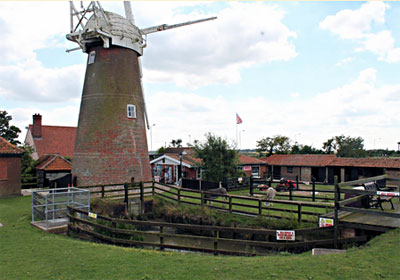 |
2014 |
In 2014 the mill was advertised along with the mill house sale, the mill being owned, insured and maintained by The Windmill Trust. The mill house owners to be paid by the WT to open the mill to the public between Easter and September from 09.00 to 20.00hrs.. |
Work has begun to restore and preserve a mill first built in the 1880s as efforts to use the site as an educational resource take shape. The Stracey Arms Mill, near Great Yarmouth, is to be safeguarded after Norfolk County Council successfully bid for £554,600 from the Heritage Lottery Fund to carry out the work. Once completed, a programme of workshops, day schools and community events will begin at the Grade II* listed mill in 2019 for people to learn more about the landmark, the local landscape and the families who lived at the site and worked on the surrounding marshes. Councillor Martin Wilby, chairman of the council's environment, development and transport committee, and also chair of the Norfolk Windmills Trust, said: "This is a fantastic project that will allow people to better understand the history of Norfolk and its historic marshes and distinctive Broads. "I am pleased it was made possible by our bid to the Heritage Lottery Fund." The work, which forms part of the £670,152 Mill and Marsh Folk project, started with the removal of the old cap and sail stocks, which have been taken to the millwright's workshop to be assessed. Any sound timbers salvaged will be reused in the new cap. Robyn Llewellyn, head of East England Heritage Lottery Fund, said: "Thanks to National Lottery players, work is now well under way. "This is an exciting moment in the restoration of such an important building from Norfolk's agricultural past and the start of a great new future." The first phase of work includes brickwork repairs, removal of internal render and the reinstatement of one of the Second World War gun loops, as well as repairs to doors and windows. The mill was built for Sir Henry Stracey of Rackheath Hall by millwright and engineer Richard Barnes of Southtown Ironworks in 1883 to replace an earlier mill on the site. It was intended to drain water off the surrounding marshes and into the River Bure, but was last used in the 1940s, serving as a fortified pillbox during the Second World War with gun loops cut into the tower to defend the local area. Major repairs were carried out in the 1960s before it became the second mill to be gifted to Norfolk County Council. The work is being led by conservation builders R and J Hogg Ltd of Coney Weston, while local millwright Richard Seago will also carry out work on new stocks and sails, as well as repairs to the turbine pump. |
Restoration of 138-year-old mill reaches high point
as cap is put back on |
It is a familiar sight to commuters and holidaymakers on their way to Great Yarmouth, a 138-year-old mill overlooking the only curve along the nine-mile Acle Straight. |
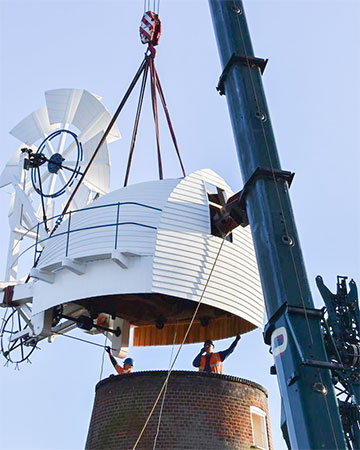
A crane places the cap back on the Stracey Arms mill between the Acle Straight and the River Bure. - Credit: Norfolk Windmills Trust |
The moment marked a high point in Norfolk County Council's 'Mill and Marsh Folk' project to restore the Grade II listed building. The cap was removed in October 2018 to be repaired by Norfolk millwright Richard Seago. In the meantime, a temporary roof has kept the mill watertight as building work on the brick tower was carried out by conservation builders R&J Hogg of Coney Weston. The restoration project, supported by a £554,600 grant from the National Lottery Heritage Fund, is returning the mill to its former glory, with a new set of sails to be installed by the end of next year. In addition to restoring the structure, the Mill and Marsh Folk project will also provide interpretation on site for visitors and educational activities for schoolchildren and community groups. Volunteering opportunities will be available for those who wish to assist visitors and help maintain the site. |
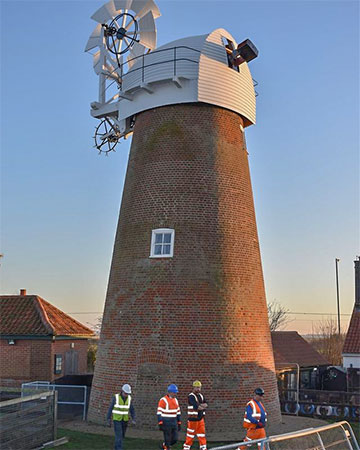
The restored cap sitting on top of the Stracey Arms mill after it was hoisted back up Thursday 16th December 2021 - Credit: Norfolk Windmills Trust |
Stracey Arms was part of a network of drainage mills that were used to control water levels across the Halvergate Marshes, one of the most extensive grazing marshes in England. It was built in 1883 for Sir Henry Stracey of Rackheath Hall by millwright and engineer Richard Barnes of Southtown Ironworks to drain water off the surrounding marshes into the River Bure. The mill stopped working in the 1940s when electric pumps were installed. During the Second World War, it served as a fortified pillbox with gun loops cut into the tower as part of the defences for the local area. The mill then gradually fell into disuse. Major repairs were carried out in the 1960s and in 1965 it was the second mill gifted to the county council to be maintained by the then newly formed Norfolk Windmills Trust. Daniel Hickey, Great Yarmouth Mercury - 18th December 2021 |
Stracey Arms Mill Shop and Tearooms, with its small car park, was operated by Dawn White from the mill site for 8 years until 2024, when it finally closed. |
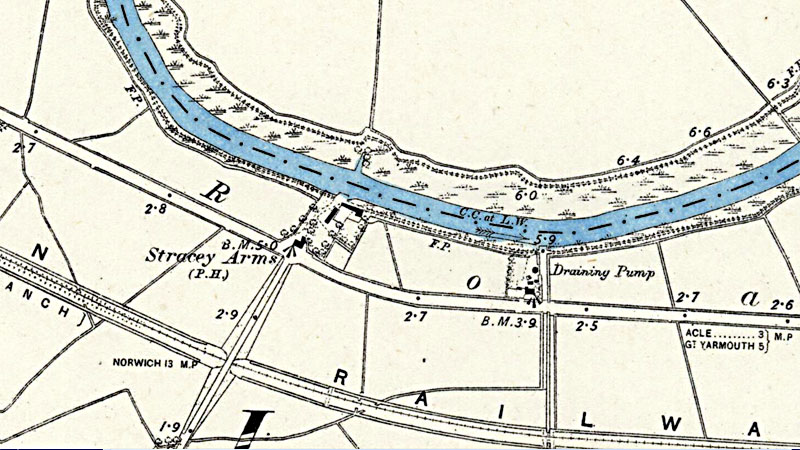 |
O.S. Map 1884 Courtesy of NLS map images |
1883: Mill built for Sir Henry Stracey of Rackheath Hall by Robert Barnes of Gt Yarmouth replacing older mill 1912: Mill extensively renovated 1939-45: Mill used as fortified pillbox during second world war 1946: Mill ceased working 1961: Restoration began by Smithdales 1965: Lady Stracey presented the mill to Norfolk CC to be cared for by the Norfolk Windmills Trust 7th April 1992: Mill cap removed for restoration October 2014: Mill & mill house advertised for sale for c.£625,000 October 2018: Restoration work begun after successful bid for £554,600 lottery grant 2021: Mill restoration work still ongoing with millwrights Richard Seago and Tim Whiting 2023: Mill restoration work completed 2024: Mill tea room closed for final time at the end of the season |
If you have any memories, anecdotes or photos please let us know and we may be able to use them to update the site. By all means telephone 07836 675369 or
|
| Nat Grid Ref TG 44160896 |
Copyright © Jonathan Neville 2024 |